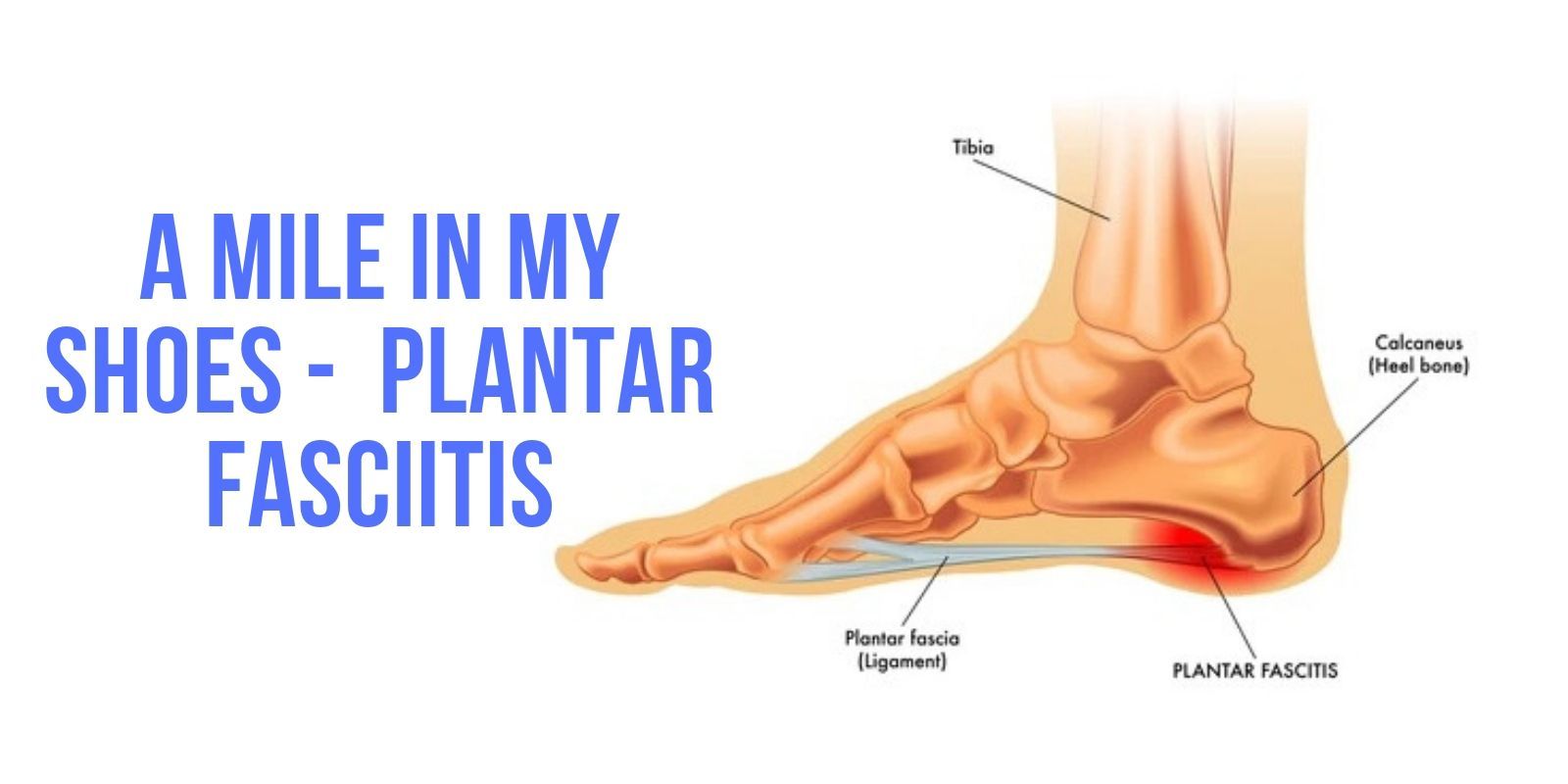Dr. Joi is a decorated physical therapist and board certified massage therapist. For nearly two decades she has successfully fused the science of physical therapy with the art and intuition of massage therapy. She also holds a bachelors degree in sports and recreation and a specialization in orthopedic manual therapy. With a wealth of knowledge and the ability to truly listen to her patients, Dr. Joi is able to deliver faster more efficient recovery from sports related injuries.You can contact Dr. Joi through her website.
Remember the old saying about walking a mile in someone else’s shoes? Well that never rang truer than the day I began to suffer with my own foot pain. To be more specific it wasn’t just any old foot pain. It was “nagging-bottom-of-the-foot-sharp-burning-can’t-get-comfortable-it-literally-feels-like-I’m-walking-on-tacks” foot pain. It was plantar fasciitis. And exactly how the word sounds, is how my foot felt. It was sharp and uniquely abrasive. It wasn’t just a normal sore foot. As I would soon find out, it would require more than just a normal treatment too.
I was fresh out of graduate school and working on my first professional job. I had to hang up my sneakers and t-shirts and donn my grown up, “business casual” apparel. #Adultingforreal. I was eager to not only feel and dress the part but to put my own “cool” stamp on it as well. I went out and purchased a pair of Steve Madden casual, sneaker-like, dress shoes. I was so excited, but my excitement was short lived. About a month after beginning my new job I started to experience sharp heel pain that became gradually worse as the day went on. I had trouble standing for any given amount of time. I would shift my weight back and forth and even onto my toes just to get the weight off my heels.
The heel pain was horrible during the first few steps I took in the morning. I started changing the way I walked to avoid the foot pain and then began to experience low back pain. I was miserable. I didn’t want to do anything except sit down and rest just so I didn’t have to experience that horrendous foot pain. I felt like the muscles on the bottom of my feet were on fire. I finally understood the agony so many before me had felt. At that time, I didn’t realize that it was much more than sore muscles contributing to my agonizing pain.
In addition to the bones and muscles located on the underside of the foot there is a huge band of thick fascia that runs all the way from the bottom of the heel to the base of each of the toes. Fascia is a band or sheath of connective tissue in the body that separates and surrounds muscles and organs. It also attaches to and stabilizes structures within the body. The fascia on the bottom of the foot is referred to as the plantar fascia. Plantar simply means “sole of the foot.”
The plantar fascia supports the muscles and arches of the feet. It helps to maintain the arch of the foot and protect the sensitive contents of the foot much like the rib cage protects the internal organs. The plantar fascia sort of reminds me of clear shipping tape, in that it is semi-flat with a super durable tensile strength. It possesses some give but it’s not what I would describe as super stretchy like a rubber band or muscle. The fascia is also slightly crinkled (like the old school paper fans we used to make as kids by folding the paper in one direction then flipping it over and folding it in the opposite direction repeatedly). These corrugations act as structural reinforcement making the fascia tough, durable and ideal for bearing heavy loads. (Super ironic that some of the smallest muscles and structures have one of the biggest jobs in the body which is to support the entire weight of the body.)
Because we must walk on our feet every day, the muscles are naturally and repetitively compressed. Muscles become squished and tight. Problems arise when damage occurs to the fascia and it becomes overloaded, damaged, irritated or inflamed. Repetitive or sudden stresses to the fascia like excessive weight gain, running, standing and walking for long periods of the time, flat feet, high arches, hard floors and wearing shoes that don’t fit properly can all damage the plantar fascia. (So basically everything that I did fresh out of graduate school.)
Left untreated, muscles of the foot, calf and even thigh will become tight and shortened. Tissues become stuck together, muscles and fascia tear and adhesions develop. Muscles lose their flexibility, good blood flow is reduced. Movement patterns unconsciously change in efforts to limit stress on the body (often resulting in increased pain elsewhere). A vicious cycle of pain and inflammation ensue.
Plantar fasciitis can be debilitating and stand in the way (pun intended) of everyday activities such as simply walking and standing. Traditional treatments may help some but often patients report pain that comes back or never fully leaves. Common treatments that are often employed by rehab specialists include icing, tennis ball massages, strengthening, stretches and splints. Icing helps to reduce inflammation in the muscles and tendons of the foot however it does not help stretch the tight muscles out to their optimal length. If the muscles are not stretched out the foot will still feel super tight and be painful (especially in the morning or after sitting still for a while). Tennis ball massages help to squeeze and soothe some of the superficial muscle tightness. Tennis ball massages do not produce sufficient enough force to successfully effect tight muscles. The ball is also soft and round so the effects are not specific and do not help to separate tight tissues and adhesions that have become stuck together. This results in super long attempts at recovery, along with temporary and limited relief from symptoms.
Although the muscles in the foot may have become tight overtime, weakness is not the root cause of the problem so strengthening (towel scrunches, marble pickups, band exercises) will do little to fix the actual problem. Stretching the muscles on the bottom of the foot improves muscle flexibility and tightness in the muscles however simple stretching will do nothing to separate the muscle adhesions and stuck tissues. Splinting allows the muscles of the foot to be supported and rest. This is done to minimize stress on the foot and allow healing to occur. Singularly and collectively these treatments are often insufficient in resolving issues of plantar fasciitis.
If it isn’t managed properly and within a decent time frame, plantar fasciitis can worsen and become so severe that it must be treated with special shoes, expensive inserts, orthopedic boots, foot injections, therapeutic modalities or even surgery. Special shoes and inserts aim to restore proper foot alignment that may be contributing to foot pain. Problem is, once the pain gets bad enough for inserts there is already damage and changes that have occurred to the muscles that must also be specifically addressed. Injections, ultrasound and electrical stimulation work to reduce inflammation and pain, but do not address the tissue changes that create the syndrome.
The only treatment combination that has successfully and consistently worked for not only myself but my patients as well, has been cupping and massage therapy. The combination of cupping and massage therapy are an efficient and affordable treatment that successfully address the root of the problem thereby resulting in shorter treatment times and better resolvement of plantar fasciitis symptoms. (Lure Essentials make the best cups on the market and they cost on average between $20-$30 for an awesome set of cups that can be used over and over for the treatment of many different ailments. Talk about the gift that keeps on giving). Massage helps to locate injured tissues, loosens stiff muscles and breaks apart adhesions. The suction from cupping therapy helps lift, pull and separate tight tissues that have become stuck together. This helps clear blockages and restore good blood flow necessary for healing.
One of my favorite cupping treatments for plantar fasciitis is simply to apply Lure Essentials smallest Edge cups or Ionic Energy cups to the sole of the foot, directly over the plantar fasciitis where most of the damage is located. The cups are best left on the foot for approximately 10 – 15 minutes. Gentle movement of the foot and ankle can be performed to help further assist with muscle stretching and flexibility while the cups are on. The same cups can be applied to the tops and sides of the foot as well at the calf to help reduce muscle tightness. Additionally, the cups can be applied in the same areas and moved in small circles, zig zags and straight-line patterns for deeper manipulation of very tight muscles. This helps unstick the tissues and lubricate them with fresh, healthy, blood which speeds healing and recovery. Once the “tissue issues” are resolved pain, inflammation and impaired postures will also resolve. Combined with massage, cupping helps resolve muscles knots, reduce pain and restore function better than typical conservative treatments for plantar fasciitis. Cupping can be used with additional accompaniments such as icing, stretching and strengthening to not only resolve symptoms but prevent them from occurring in the future. It is definitely a super star in the treatment of plantar fasciitis.









